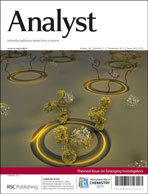Several experimental parameters affecting surface enhanced Raman (SER) signals using 488, 785 and 1064 nm excitation for eight diverse analytes are reported. Citrate reduced silver colloids having average diameters ranging from 40 ± 10 to 100 ± 20 nm were synthesized. The nanoparticles were characterized by transmission electron microscopy, dynamic light scattering and absorbance spectrophotometry before and after inducing nanoparticle aggregation with 0.99% v/v 0.5 M magnesium chloride. The nanoparticle aggregates and SERS signal were stable between 30 and 90 minutes after inducing aggregation. For the analytes 4-mercaptopyridine, 4-methylthiobenzoic acid and the dipeptide phenylalanine–cysteine using all three excitation wavelengths, the highest surface area adjusted SER signal was obtained using 70 ± 20 nm nanoparticles, which generated 290 ± 40 nm aggregates with the addition of magnesium chloride. The decrease in the SER signal using non-optimum colloids was 12 to 42% using 488 nm excitation and larger decreases in signal, up to 92%, were observed using near infrared excitation wavelengths. In contrast, pyridine, benzoic acid, and phenylalanine required 220 ± 30 nm aggregates for the highest SER signal with 785 or 1064 nm excitation, but larger aggregates (290 ± 40 nm) were required with 488 nm excitation. The optimum experimental conditions measured with the small molecule analytes held for a 10 amino acid peptide and hemoglobin. Reproducible SERS measurements with 2 to 9% RSD have been obtained by considering nanoparticle size, aggregation conditions, excitation wavelength and the nature of the analyte–silver interaction.

You have access to this article
 Please wait while we load your content...
Something went wrong. Try again?
Please wait while we load your content...
Something went wrong. Try again?


 Please wait while we load your content...
Please wait while we load your content...